|
VOLTA'S LOCALITIES
Volta's life and works Chronology Selected reference
The Alessandro Volta's house
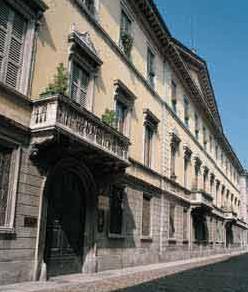 Alessandro Volta was born in Contrada di Porta Nuova nr. 10 in Como. He was baptized in the San Donnino's Church which is a few hundred meters away from his house. After the death of the great scientist the Town-Council of Como with unanimous approval, in 1888 decided to dedicate the street to the physicist and sice then Contrada di Porta Nuova was registered in the toponomy section of the town as Via Alessandro Volta. By the new numbering, the Alessandro Volta's house has now the number 62. Alessandro Volta was born in Contrada di Porta Nuova nr. 10 in Como. He was baptized in the San Donnino's Church which is a few hundred meters away from his house. After the death of the great scientist the Town-Council of Como with unanimous approval, in 1888 decided to dedicate the street to the physicist and sice then Contrada di Porta Nuova was registered in the toponomy section of the town as Via Alessandro Volta. By the new numbering, the Alessandro Volta's house has now the number 62.
Via Volta, one of the old patrician streets, holds, still today, interesting evidences from the historical and architectural point of view.
The Porta Nuova's Tower (Gattoni Tower)
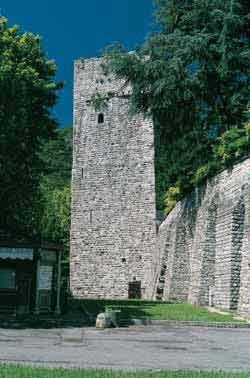 First its name was Torre di Porta Nuova since it was built in the district of Porta Nuova between the XIV and XV century. It was added to the existing town walls, which were built against the Emperor Freidrich Barbarossa. This prismatic tower is different from the two existing towers located along the old perimeter of the two walls. First its name was Torre di Porta Nuova since it was built in the district of Porta Nuova between the XIV and XV century. It was added to the existing town walls, which were built against the Emperor Freidrich Barbarossa. This prismatic tower is different from the two existing towers located along the old perimeter of the two walls.
From 1783 to 1806 the inside of the tower was used by the Canon Giulio Cesare Gattoni, as physical laboratory. In the same laboratory Volta made his researches. Since he had no scientific means available, Volta was using all the instruments of Gattoni and still young he became well known in the field of physics. An electric power station was installed inside it since 1978. Now that tower is called Torre Gattoni and no visit is allowed.
The high-school Alessandro Volta
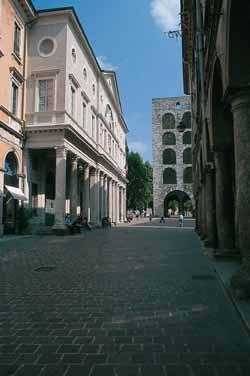 The school career of Volta starts just from the High Schools of Como on October 22, 1774. Then in 1776 he taught physics by the State Gymnasium always in Como. By means of the power of his intellect and his spur, he succeeded in raising his pupils to highly desirable technical and cultural level. The school career of Volta starts just from the High Schools of Como on October 22, 1774. Then in 1776 he taught physics by the State Gymnasium always in Como. By means of the power of his intellect and his spur, he succeeded in raising his pupils to highly desirable technical and cultural level.
In memory of his work in 1865 the bust of Volta was unveiled, and during this ceremony the school was called Liceo Alessandro Volta.
From the cultural point of view this building is particularly interesting because of its roman columns forming the inner colonnade, while from the historical point of view its importance is stressed because of the work carried out by the great physicist.
Nowadays this school is a high school specializing in classical studies and till a few years ago some halls were used as Town Library. They are housed a little museum with some Volta's instruments.
The San Provino's Church
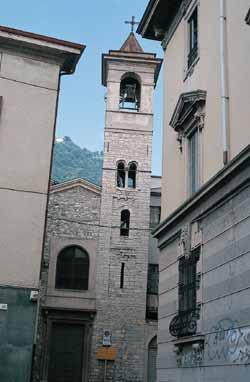 This church should be mentioned separately because of its long history with so many interests and different interpretations about its origins. Alessandro Volta married with Donna Maria Alonsa Teresa Peregrini on the September 22, 1794 in this church. This church should be mentioned separately because of its long history with so many interests and different interpretations about its origins. Alessandro Volta married with Donna Maria Alonsa Teresa Peregrini on the September 22, 1794 in this church.
The Theater Sociale
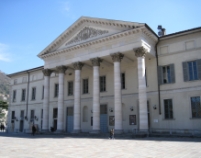 The history on the Teatro Sociale is connected with Volta because in the evening of the January 31, 1809 the physicist, as a town representative, presided over a meeting when the construction of the theater was decided at Piazza Verdi, few hundreds meters away from the Broletto and Piazza Duomo. The history on the Teatro Sociale is connected with Volta because in the evening of the January 31, 1809 the physicist, as a town representative, presided over a meeting when the construction of the theater was decided at Piazza Verdi, few hundreds meters away from the Broletto and Piazza Duomo.
This building gave rise to violent polemics, sometimes not groundless, such as the indignation of the historian Marquis Giuseppe Rovelli, who was fond of town old monuments, because the Torre Rotonda (Round Tower), one of the most famous old monuments of the town, was demolished in order to build up the theater.
The Campora house
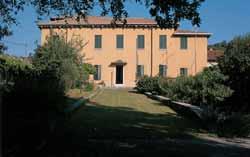 Camnago Volta is a hamlet near Como on the hill slopes, were is the country-house of Volta. This house always was a steady reference-point for him, when the political storm was raging and he ran the risk of being overwhelmed. On the marble table which is still well solid in the garden, the physicist made his experiments for the realization of the Pile, and in the alleys he used to walk absorbed in thought and in deep meditation about his scientific assumption. Camnago Volta is a hamlet near Como on the hill slopes, were is the country-house of Volta. This house always was a steady reference-point for him, when the political storm was raging and he ran the risk of being overwhelmed. On the marble table which is still well solid in the garden, the physicist made his experiments for the realization of the Pile, and in the alleys he used to walk absorbed in thought and in deep meditation about his scientific assumption.
The Volta's Grave
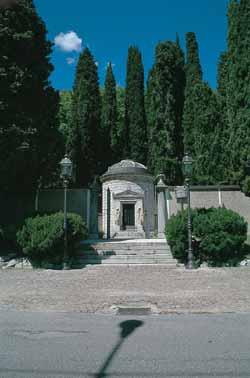 The great physicist was not forgotten after his death and the Town Council of Como on March 23, 1827 awarded an allocation of 30 Liras for the erection of a monument and the striking of a memorial medal. The great physicist was not forgotten after his death and the Town Council of Como on March 23, 1827 awarded an allocation of 30 Liras for the erection of a monument and the striking of a memorial medal.
The corpse was buried for the time being in the old cemetery waiting for the family grave to be completed. Four years later his corpse was exhumed and was buried in the new cemetery of Camnago Volta where the family had built a small round temple with a bust of Volta sculptured by G.B. Comolli.
The Alessandro Volta Square
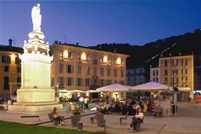 First this square was called Piazza Ajasca (or Piazza Jasca) can be considered as the first soccer stadium in Como not only because children were playing soccer, but also because some matches took place with almost professional men. First this square was called Piazza Ajasca (or Piazza Jasca) can be considered as the first soccer stadium in Como not only because children were playing soccer, but also because some matches took place with almost professional men.
After Volta's death , the Town Council decided to call Piazza Ajasca with his name. The first step was done by the Governor of Lombardy Count d'Hartig, who laid the foundation stone of the monument in the great physician's memory, on september 22, 1834, i.e. seven years after Volta's death. After erecting this monument, the town council decided by one consent to give the square the famous physician's name.
The Volta Temple
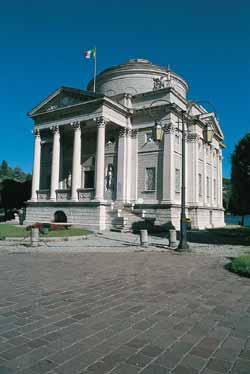 The Tempio Voltiano is considered by the inhabitants of Como as a vivid memory of Alessandro Volta. This building has been since many years a compulsory destination of tourists visiting Como, who are anxious to look for anything that was held by the great scientist. The Tempio Voltiano is considered by the inhabitants of Como as a vivid memory of Alessandro Volta. This building has been since many years a compulsory destination of tourists visiting Como, who are anxious to look for anything that was held by the great scientist.
The temple was built in the year 1927, on the lake border near of the public park, of the hundredth anniversary of Volta death and it was one of the many demonstrations of the general estimation and memory given to Volta by his town and the entire world.
Entry to the temple is now allowed and it can be reached after a pleasant wolk through the public park.
San Maurizio - Volta Lighthouse
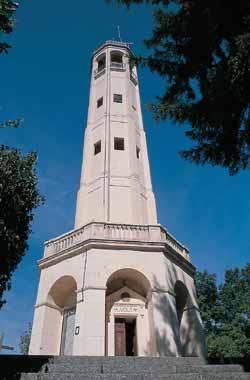 Once we leave Brunate, at over twenty minute's walk, among beautiful villas immersed in green parks, rich of secular trees, we reach S. Maurizio, where Volta's lighthouse is placed. Once we leave Brunate, at over twenty minute's walk, among beautiful villas immersed in green parks, rich of secular trees, we reach S. Maurizio, where Volta's lighthouse is placed.
From its top we may enjoy a sightseeing which, as if by magic, allows a "wide-angle" view on the lowland and mountain range of Alps, where Monte Rosa mass rises much higher the horizon line, making visitors rapturous.
To celebrate Alessandro Volta, the Italian physicist from Como, that was just he who invented the voltaic pile in 1800, the Italian Post and Telegraph employees contributed to carry out this grand work, which was designed by engineer Gabriele Giussani.
This lighthouse can sweep over an angle of more than 200 degrees; wheeling at a speed of one turn in a minute time, it projects a series of light green, white and red rays, alternatively: these beams of light are visible from over 50 km.
The opening cerimony dates back to 1927.
Volta's life and works Chronology Selected reference
|


